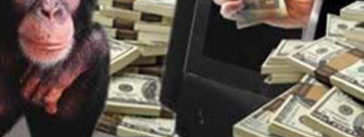In this episode of Truth About FX, Walter talks about becoming a successful forex signal provider. What are the things you should keep in mind and do you have the right outlook to pursue it? According to him, the’re an easy trick to help you attract subscribers and give you the edge. There’s also this very easy to use tool that can help you set-u risk parameters… And who is this signals-guy Walter is talking about and how you can learn a thing or two in finding your niche.
Download (Duration: 13:59 / 33.6 MB)
In This Episode:
00:31 – worth the trouble?
02:21 – 45 degree angle
04:23 – a realized drawdown
06:49 – capped or double it
07:22 – smart guys do
09:20 – dump you
10:57 – signal provider platforms
12:40 – leverage rules
Tweetables:
Have the right outlook [Click To Tweet].
Why do you like Martingale? [Click To Tweet].
Set the Expectations [Click To Tweet].
Announcer: Sometimes, forex trading is a wild and wooly place to be. That’s why Hugh is here, to post your questions to Walter, the naked forex guy. Hugh’s got questions and Walter’s got the answers. Here at the Truth About FX Podcast.
Hugh: Hi, Walter. How do you become a successful forex signal provider and is it worth it? Is it worth all that trouble?
Walter: There’s a couple of things that you have to think about. It’s a great question, Hugh. With the signals, there’s you, the signals provider. There are the subscribers and then there’s actually the platform, the technology. All of them have to have the right outlook otherwise, you’re going to be in trouble.
For example, let’s say you do it and you take really quick trades on a M15 charts. What might happen is that they’re not going to be executed quickly enough through the platforms. So there’s going to be a bit of a lag by the time the subscribers get it triggered in their account and you’re going to have a lot of unhappy subscribers.
That’s one thing. The shorter time frame stuff often won’t work. So, as a signal provider, you’ll probably want to be trading above the H1 charts, most likely. That’s number one. Some of them are better than others. Some of the signal providers have better technology than others. That is one thing to keep in mind.
Another thing to keep in mind is that if you look at some of these and I’ll link some up in the show notes. If you look at some of these signal provider websites, they’ll often rank which ones are the best traders or which ones are the highest rank traders. You can sort them usually by drawdown or returns or whatever you want. The interesting thing is, that the most popular trading strategies are essentially Martingale Strategies which I suppose shouldn’t really be all that as surprising.
But what that means is — think about it this way — your subscribers, the people that you’re trying to attract, they want a system that just keeps taking winner after winner, after winner and that just goes on a 45 degree angle straight up.
Of course, that is what everybody wants but obviously in the end, when the Martingale Strategy finally pops then everyone loses everything and then you lose all your subscribers. But there are people that just repeatedly keep uploading these Martingale Strategies to the signal provider websites and that’s what they do.
They’ll get a pile of subscribers in. They’ll get lots and lots of people. I think it’s amazing that it keeps making money until of course it hits the ultimate drawdown and then it’s done. So, just keep that in mind that it’s hard to educate your subscriber base.
If you trade, for example, and you risk let’s say 2% per trade. And let’s say that “Oh, I couldn’t do the quick math on this. I’m going to bring up my handy dandy risk calculator — that I will link up in the show notes too that I seem to always refer to.” So, let’s say that I’m risking 2% per trade and I know for example based on that if I’m actually risking 2% per trade and I have a 65% win rate. My average winner is twice as big as my loser.
I risk a $1000 to make $2000. I’m risking 2% per trade. So, my question is over the next thousand trades, am I going to have a 30% drawdown? The answer is no. Am I going to have a 15% drawdown? The answer is yes. Possibly going to happen, pretty much like a 2 out 10 chance of a, we’ll move it to a less than a 210 chance of a 15% drawdown with this strategy. Certainly almost guaranteed I’ll have a 10% drawdown. Like an 80% chance of a 10% drawdown.
Think about that. So remember these are people that, what do we know about these traders? We know that they really like Martingale Strategies. Why do we like them? Because there’s really kind of no drawdown. There’s never really a realized drawdown until you get that ultimate losing trade at the end and the it closed up the account.
These traders are going to have to sit through and watch you with the 65% win rate. A 2:1 reward to risk ratio. If you’re risking 2% per trade, they’re going to have to see you have a 10% drawdown. That is going to happen.
If they have a $1000 with you, they’re going to lose at least a 100 bucks. If they have $20,000 they’re going to lose at least $2,000 and they’re going to have to stick with it. What you’ll notice as a signal subscriber or as a signal provider, is that your subscribers always leave right about the time when you are about to have a winning streak.
It’s totally true. Anyone can tell you. As soon as you have 6, 7, or 8 losing trades in a row and you’re in a drawdown, and then as soon as you really going to hit it and just boom, boom, boom, boom and get a bunch of really lovely trades and ramp up that equity curve, that’s when you’ll have the fewest number of traders.
So, it’s just something to keep in mind. You can try and educate these guys and tell them as best as you can. I would do this. This is what I would do and this is the same thing you’d do if you were signing someone on and you’re going to trade their account.
What you would want to do upfront is say, “Look, you’re willing to sit through a drawdown of x%” So, they’d sign the contract. I will keep this money with you for the next 3 years so long as we keep the drawdown under 20%. That’s the maximum drawdown that I will accept.
If we hit 20% or go beyond 20% drawdown, we will stop trading immediately and then reassess the situation. They can either decide to pull their money or keep going or whatever but you can’t trade anymore.
You can do the same thing as a signal provider, you can say, “Look,” — and you can use my risk calculator that you guys can get in the show notes here to figure this out — “.. I am telling you, we will not have a 15% drawdown.” I’ve set up my risk parameters here so that if you’ve copy my trades precisely, you will only have a drawdown up to 40% but we’ll never hit 50%, that’s my goal.
So, what you’re trying to do is set the expectations so that they’ll know what to expect. Now, the problem of course is that some of the signal providers, they can adjust it. They can take a 1:1 trade so that your account is merely capped or double it. If they double it, now maybe it’s up to 30% drawdown or 45% drawdown and triple it. You just have to keep it in mind.
It’s not guaranteed that they’re going to do what you said but you can make it really clear and some of these guys do. They say, “Look, this is the strategy. It’s not Martingale. We’re going to have losers but I guarantee you that if you hook it up, we’re not going to have 50% drawdown. I’ve setup my stats so that we won’t.”
So, that’s one way to kind of try to educate your group and all the smart guys do. You’ll see in them. They’ll say, “Look, this is a non-Martingale. It’s not a Martingale” and they’ll tell a little bit about the strategy. They’ll usually don’t want to give away their secret sauce or whatever.
The point is, they try to educate their market. That’s really the key here and to know that you’re going to lose and a lot of your subscribers will jumpship when you’ll have a drawdown. And then right as you’re starting to turn around and you have a really nice winning streak, you’re going to have the fewest number of subscribers. That is just the way it works. I just don’t know what to tell you.
It’s the same reason, by the way, it’s the same reason why when you look at the open position ratios which I’ll link up in the show notes too for this episode. When you look at open position ratios that just tells you what percentage of traders are long or short.
When most of the traders like right now, as we’re recording this, Hugh. I am looking at the Swissie and the Euro/Aussie. So the Euro/Aussie and the Swissie — I’m just going to bring it up so I’ll just know it’s updated — On the Swissie 66.9% of traders are going to go long the Swissie and 33% are going to go short. I want to be in that small group. I want to be shorting the USD/CHF.
And then the Euro/Aussie, 64% are shorting it so I want to be in the 35% that are going long or the Euro/Swiss actually is another one. I am in the 28.5% group of traders that are going long Euro/Swiss right now and 71.5 are going short Euro/Swiss.
So, it’s the same thing when a lot of traders all get it on one side, it usually means the market is going to go the other way because all these traders are wrong. They don’t make money consistently and they’re wrong. It’s the same thing with your signal provider or your signal subscribers.
As a provider, they’re going to be wrong. You have to understand, your subscribers will be wrong. They will dump you at the worst time and they’ll usually join you at the worst time too. They’ll see you when you’re on a hot streak and then they’ll say, “This guy is amazing” and they’ll pile in and join you and subscribe and then of course than you do when you’re in a losing streak.
It’s crazy. The whole thing is madness but that is just the way it works. You just have to understand human nature and try to educate your subscribers as best as you can. I don’t know if it’s for everyone but I mean, we have a couple of traders in our community that do these and they make some money on the side.
I think Frank Walbaum does it. I think also, Denis Switalski. He also does it. There’s a couple of guys out there that actually do these. It’s just like a little side thing that you can do. There’s nothing wrong with this. You just have to understand how people will be.
Hugh: It could be an opportunity for something bigger later.
Walter: Yeah, that’s what Denis did actually. You bring up a great point. That is how Denis has got noticed with his signals accounts and he was able to turn that into some investors. His investors came from these guys that are kind of scroll through all these signal providers and they looked for the ones they like.
Of course, Denis does a really good job of limiting his drawdowns so, that is kind of how he found his little niche there and got some investors to partner up with him. You’re absolutely right. It’s a great way to do that.
Hugh: Yeah. Super cool. Thanks for all the tips. One last question. I know this is going to be asked. Are there any signal provider platforms that you’ll recommend or not really?
Walter: They’re all out there. The one that I know the most is Signal Start just because I know Denis was on there and there was a lot of them on there. I’ll link some up for you guys. I think there’s ZuluTrade is one too. There’s a couple of other ones. I think, actually My FX Book, does it have a thing? It used to kind of have a thing.
Hugh: Yeah, they used to have a copy thing.
Walter: Copy thing. I don’t know if it still does but there’s a lot of these ones out there. I’ll link up Signal Start and ZuluTrade. eToro is another one. As a signal provider, if you’re thinking you want to be a provider, you want to find the one that has a lot of people in there.
People kind of think, they want to go with the one where they’ll get the largest chunk of the subscription. The way it works typically is the company that has the platform, they’ll make some of the money too of these subscribers and you make a little bit of it.
So, keep in mind that just because you’re getting a larger chunk on another platform, a larger payout in terms of percentage, you might actually make more money if you’re on another platform that’ll give you less percentage but has more people on it.
So, keep in mind because I think eToro is pretty big and probably much bigger than for example like Signal Start or something. Also, as a forex trader, if you are a forex trader, make sure that you understand their leverage rules because sometimes what will happen is like, if you’re in a FuturesOne, — this happened to me before — if you’re in a FuturesOne or something like that, what they’ll do is they’ll give you really low leverage.
And so what happens is you run out of leverage and you can’t take anymore trades. So, there’s a lot of different things you need to do. Keep in mind, make sure that you’ll go through their terms and conditions and stuff like that because you want to make sure that or maybe they just assume everyone has got US accounts so you’re going to be at 50:1 leverage or whatever.
So, just make sure that you understand that because that’s another thing that can throw you off. If you typically have 6 or 7 trades running, you might have to reduce your risk per trade quite a bit to make sure you can keep all those running if you have one of those platforms where they significantly reduce your leverage. Keep that in mind too.
Hugh: Okay, cool. It’s a lot of great tips. Thanks a lot, Walter.
Walter: Thank you.
Podcast: Play in new window | Download
Subscribe: Apple Podcasts | Android | RSS



 EP82: Copy Successful Forex Traders: How Long of a Track Record?
EP82: Copy Successful Forex Traders: How Long of a Track Record? EP69: Are Trend Traders Mostly Counter Trend Traders?
EP69: Are Trend Traders Mostly Counter Trend Traders? EP63: Do You Risk More?
EP63: Do You Risk More? EP107: Discretionary Traders: What are they?
EP107: Discretionary Traders: What are they?
Leave a Reply